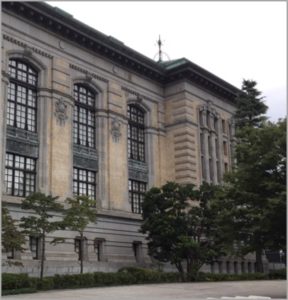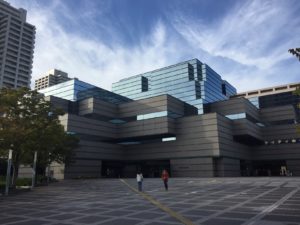|
Children’s Literature Libraries in Japan Christiane Lütge |
Download PDF |
The International Library of Children’s Literature, Tokyo
For all children, reading activities are indispensable to learn languages, to cultivate sensitivity, to heighten power of expression, to enrich creativity and to acquire power for living life more deeply.
This statement, from the Japanese Act on Promotion of Children’s Reading, can be found in the mission statement of the International Library of Children’s Literature (ILCL) in Tokyo (http://www.kodomo.go.jp/english/about/profile.html). This library lives up to its goals by providing an extremely fitting environment in which all children can enjoy the pleasure of reading. As the sole national library in Japan dedicated to children’s books based on the Japanese National Diet Library Law, the ILCL aims to realize the philosophy that ‘Children’s books link the world and open up the future!’ through supporting activities and research related to children’s books by using its abundant domestic and foreign materials and resources.
Figure 1: The International Library of Children’s Literature, Tokyo [End of Page 45]
The ILCL was founded in the year 2000 and is housed in a modernized historic building, both impressive and spacious, situated in Ueno Park in the city centre of Tokyo. The main three objectives, when setting up the library, were to establish a library dedicated to children’s books, to create a place where children can encounter books, and to be a museum of children’s books.
The ILCL’s holdings provide materials for users up to 18 years, which include 279,000 Japanese books, 93,000 foreign language books from about 140 countries, 2,000 Japanese magazine titles, 184 foreign language magazine titles and 10 Japanese newspapers. The library is also home for several collections:
- The Nobumasa Ikeda Collection, containing 860 works of the Japanese author.
- The Ingram Collection of about 1,150 mainly British children’s books from the 18th to 20th
- A microfilm archive of the Gordon W. Prange Children’s Book Collection containing around 8,000 children’s books published in Japan between 1945 and 1949 (the originals are housed in the University of Maryland Library).
From April 2014 to March 2015 the library received 102,368 visitors, using the different on-site services, as reading-rooms for children and teenagers, but also the separate facilities for research. The ILCL also provides lectures, exhibitions and tours for visitors. Via the internet, different digital library services allow interested viewers to browse through the various collections and digital materials, including the National Diet Library (NDL), The International Library of Children’s Literature Online Public Access Catalog for Kids, the NDL Digital Collection of different digitalized materials held by the NDL, and the Online Gallery, where each exhibition is organized thematically, using digital images combined with commentary.
An excellent timeline (http://www.kodomo.go.jp/jcl/e/index.html) provides an interesting and well-structured approach to the history of Japanese children’s literature, a perfect starting point for everyone who wants to get familiar with the different historical phases of children’s literature in Japan.
Further information about the ILCL can be found here: http://www.kodomo.go.jp/english/about/index.html [End of Page 46]
The Centre for International Children’s Literature, Osaka Prefectural Library, Osaka
As a visitor to the Centre for International Children’s Literature, also known as the International Institute for Children’s Literature, the distinctive design of the building – with the shape of stacked books – immediately catches one’s eye. The visual aesthetics of the building is impressive, and is also mirrored in the entrance hall and the spacious lobby.
Figure 2: The Centre for International Children’s Literature, Osaka
The Centre for International Children’s Literature opened in 2010, inheriting about 700,000 resources related to children’s literature and culture from the Osaka Prefectural Institute for Children’s Literature at Banpaku-koen in Suita city. The library’s collection includes books, magazines, manuscripts, original pictures, literary magazines, picture cards, posters and leaflets, much of which has been donated. Visitors wishing to study children’s literature can also view reference books and microfilms. The children’s room is specially designed with areas of tatami matting, as well as tables and chairs, to create a more informal atmosphere for reading and enjoying books. [End of Page 47]
The library’s main activities include lectures and courses on children’s literature and reading promotions (for librarians, teachers, parents and children), the Nissan Children’s Storybook and Picture Book Grand Prix and the ‘Hon-Navi Kids (Book Navigation for Kids)’, which fosters reading activities through the internet. The Centre is not only domestically active, but also internationally, as it is responsible for the International Brother’s Grimm Award for Research into Children’s Literature, and exchanges information and materials with other overseas institutions. Also, the Centre participates in the Activity of Liaison Council of Promotion for Child Reading Activity in Osaka Prefecture and members of the Centre engage in research and offer different publication projects.
Information about the Centre for International Children’s Literature can be found here: http://www.iiclo.or.jp/f_english/01_guidance/index.html
Christiane Lütge is Professor and Chair of Teaching English as a Foreign Language at the Ludwig-Maximilians-Universität in Munich. Her research interests include digital literacy and literary learning, children’s literature in foreign language teaching, transcultural learning and citizenship education in EFL, standards and competences in foreign language learning and teacher education. Her current research examines digital literature with a focus on literary applications and the impact of these new (digital) narratives on the development of literary literacy. [End of Page 48]



